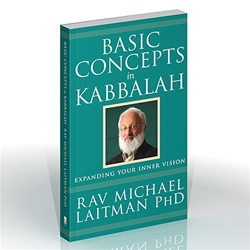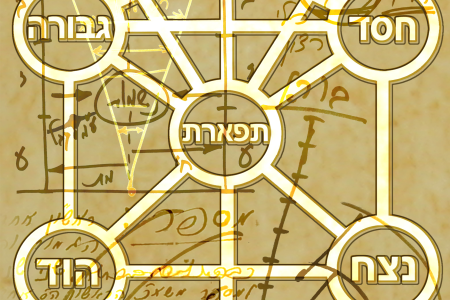Memorize the Pivotal Pattern in the Map to Avoid Being Lost at Sea
The Zohar was concealed from the uninitiated from the day of its creation. Now, the conditions have ripened for its disclosure to the public. To make The Zohar accessible to every reader, we must precede it with some explanations.
First, it should be noted that everything described in The Zohar is an order of ten Sefirot: Keter,Hochma, Bina, Hesed, Gevura, Tifferet, Netzah, Hod, Yesod, Malchut, and their combinations. In the same way that languageexpresses any thought with a limited number of letters in the alphabet, so are the combinations of the ten Sefirot sufficient to describe every spiritual action or object.
Know Three Boundaries That Serve as Landmarks for the Spiritual Sailor
There are four levels of perception (or attainment) in our world:
1) Matter,
2) Form in Matter,
3) Abstract Form, and
4) Essence.
These four levels of attainment also exist in each of the ten Sefirot. However, there are three clear boundaries one should always keep in mind, connected to the four levels of perception (or attainment) in our world. Understanding what these boundaries, or limitations, are will help you appreciate just what it is that The Zohar researches, and what it does not.
The first boundary: The Zohar researches only Matter and Form in Matter, but it in no way concerns itself with Abstract Form and Essence.
The second boundary: While all that was created is arranged into three levels, The Zohar studies only the third, or last, level–the worlds of Beria, Yetzira, and Assiya (BYA). It does not study the worlds Ein Sof and Atzilut in and of themselves, but only what the worlds BYA receive from Atzilut and Ein Sof.
These are the three levels of Creation:
- The world Ein Sof (Infinity);
- The world Atzilut;
- The worlds Beria, Yetzira, and Assiya (BYA). (This is the level that is studied in the Zohar.)
The third boundary: The Book of Zohar studies human souls, whereas all other objects are analyzed only with respect to human souls. Therefore, even though each of the worlds BYA consists of three subdivisions, The Book of Zohar focuses on the human soul. The following are the three subdivisions within each of the worlds of BYA:
- The Ten Sefirot that constitute the Creator’s part in each world;
- Human souls; (This is the subdivision that The Book of Zohar studies. The other two subdivisions are considered only as they relate to human souls.)
- Everything else that exists
It is worth noting that all mistakes, inaccuracies, and delusions regarding The Book of Zohar are the results of losing sight of these three boundaries of what it is that The Book of Zohar researches. If we maintain a clear understanding of the focus of research in The Book of Zohar,we will avoid countless confusions.
Chart Correspondencesthat Will Enlighten & Simplify Your Journey
Of the worlds that have been mentioned and the ten sefirot, correspondences can be arranged. Examine the sefirot that correspond to the following four reviewed worlds (Atzilut, Beria, Yetzira, Assiya):
- Sefirat Hochma (sefira of Hochma) corresponds to the world Atzilut;
- Sefirat Bina corresponds to the world Beria;
- Six sefirot correspond to the world Yetzira. They are the sefirot from Hesed to Yesod (Hesed, Gevura, Tifferet, Netzah, Hod, and Yesod). These six sefirot are often referred to collectively as Tifferet.
- Sefirat Malchut corresponds to the world Assiya.
All that exists above the world Atzilut refers to Sefirat Keter
Finally, the Fog Surrounding The Zohar Lifts
While we now understand that each world corresponds to a particular sefira, there is more to it than that. However, each of the above worlds is also divided into ten Sefirot. In fact, even the most infinitesimal object in any of the worlds is divided into (or consists of) ten Sefirot.
Gradually, as we study, we come closer to feeling the spiritual world. Baal HaSulam added an explanation to the original text of The Zohar using the language of Kabbalah that we have been describing. He explains The Book of Zohar in terms of Partzufim, worlds, and Sefirot. As we study The Book of Zohar, gradually we will begin to feel that this language of Kabbalah that describes worlds and sefirot is saying the same thing as The Book of Zohar’s original text. We will begin to understand this language since we will become “specialists” in it, like musicians or doctors who understand their language. The language of Kabbalah will enable us to feel a clear sensation, and then we will be impressed by what we read.
Dr. Michael Laitman in “The Perturbing Language of Partzufim and Sefirot.”
 “Priceless Orientation to Keep You On-Course When Sailing Through The Zohar” is based on the book, Basic Concepts in Kabbalah: Expanding Your Inner Vision by Dr. Michael Laitman.
“Priceless Orientation to Keep You On-Course When Sailing Through The Zohar” is based on the book, Basic Concepts in Kabbalah: Expanding Your Inner Vision by Dr. Michael Laitman.

